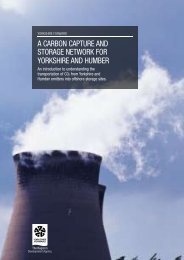Final report for One North East And NEPIC 21/12/10 - The Carbon ...
Final report for One North East And NEPIC 21/12/10 - The Carbon ...
Final report for One North East And NEPIC 21/12/10 - The Carbon ...
Create successful ePaper yourself
Turn your PDF publications into a flip-book with our unique Google optimized e-Paper software.
<strong>The</strong> case <strong>for</strong> a Tees CCS network<strong>Final</strong> Reportinvestors in the project 94 .Our discussions and survey of Teesside stakeholders, legalexperts and financiers did not highlight this aspect as an issue. As highlighted previously,there is a long track-record on Teesside of private self-regulated cooperation on pipelineinfrastructure, and well established contractual procedures in place to accommodate sucharrangements.In our view, Teesside operators are well-positioned to self-regulate the development of aCO 2 network in the Tees Valley absent of the need to establish an independent regulator.Government policy in this area is unclear, although it has been mooted that the Office ofGas and Electricity Markets (OFGEM) could serve such a purpose.6.5 Onshore and offshore developmentWhilst most of the previous discussion has refrained from considering technical split of thesystem, the onshore and offshore components of the transportation vary significantly inengineering requirements and costs. However, the value chain <strong>for</strong> CCS in Teesside could– with the emergence of EOR – build from both the source and sink, with different drivers<strong>for</strong> entities at each end of the value chain. Further, the onshore pipeline is more akin to alow-pressure distribution network, taking CO 2 from sources (suppliers), with scope <strong>for</strong>phased development of various pieces of the grid as new connections emerge, and costsin the region of £50 million – these are aspects well within the technical competencies andbudgets of the Teesside operators. <strong>The</strong> offshore pipeline is more akin to a high-pressuretransmission system, with limited scope <strong>for</strong> phased development, potentially driven by CO 2demand <strong>for</strong> EOR, with costs in the hundreds of millions – this lies closer to the technicaland financial remit of major energy companies. In our view, this suggests a natural breakin ownership between the two components, pivoted around the onshore coastal boosterstation.Our analysis suggests that the onshore network could be promoted and developed by a„coalition of the willing‟ made up of Teesside operators, via a JV consortium and using aproject finance model (SPV). We consider that there is significant potential to build anappropriate vehicle through which to promote and develop the project, building on existingrelationships and structures in the Tees Valley (e.g. the <strong>North</strong> <strong>East</strong> Process IndustryCluster; <strong>NEPIC</strong>) – to this end, ten <strong>NEPIC</strong> members have already signed up to aCollaboration Agreement – the Process Industry <strong>Carbon</strong> Capture and Storage Initiative(PICCSI) to further explore potential of a CCS network. This is the first small step in theprocess of moving towards a JV, as described previously.At this stage of developments, the most effective strategy <strong>for</strong> Tees Valley operatorsprobably involves building a robust business case – with associated estimates of costs andrevenues, and the structure under which this could move <strong>for</strong>ward – involved with deliveringCO 2 to a coastal location at transmission pressure (i.e. with low impurities and pressure inthe order of 180 bar). This could serve to “tease out” the views potential CO 2 takersoffshore – presently these entities seem to be keeping their plans – if any – out of thepublic domain. Under this strategy, potential takers could then be left with the commercialchoice on how they might want to valorise the CO 2 “asset” at the coast – either by shippingor through pipeline construction. This could help bring the two ends of the value chaintogether.94 CO2sense Yorkshire. Commercial and financial structuring options <strong>for</strong> a CO 2 network in Yorkshire andHumber. Brochure/Executive Summary. 2009.63







